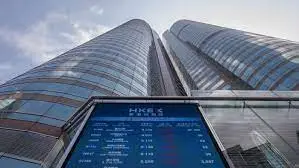The Hang Seng Index (HSI) is a stock market index that tracks the performance of the largest companies listed on the Hong Kong Stock Exchange. Created in 1969, the HSI is one of the most widely followed indexes in Asia and is considered an important barometer of the Hong Kong stock market’s health. In this article, we’ll take a deep dive into the HSI, exploring what it is, how it works, and how investors can use it to inform their investment decisions.

What is the Hang Seng Index?
The Hang Seng Index, also known as the HSI, is a market capitalization-weighted index that tracks the performance of the largest and most actively traded companies listed on the Hong Kong Stock Exchange. The index was created in 1969 and is maintained by Hang Seng Indexes Company Limited, a subsidiary of Hang Seng Bank. The HSI is considered an important barometer of the Hong Kong stock market’s health and is widely used by investors and analysts to track the performance of Hong Kong’s largest companies.
How is the Hang Seng Index Calculated?
The Hang Seng Index is calculated using a formula that takes into account the market capitalization of each company included in the index. Market capitalization is calculated by multiplying a company’s share price by the total number of outstanding shares. Companies with a larger market capitalization have a greater weighting in the index, which means their performance has a greater impact on the index’s overall performance.
What Companies are Included in the Hang Seng Index?
The Hang Seng Index includes 50 of the largest and most actively traded companies listed on the Hong Kong Stock Exchange. These companies are divided into four categories: finance, utilities, properties, and commerce and industry. The finance category includes companies such as HSBC Holdings, Bank of China, and China Construction Bank. The utilities category includes companies such as CLP Holdings and HK Electric Investments. The properties category includes companies such as Sun Hung Kai Properties and Cheung Kong Property Holdings. The commerce and industry category includes companies such as China Mobile, Tencent Holdings, and Ping An Insurance.
How is the Hang Seng Index Used by Investors?
The Hang Seng Index is used by investors in a variety of ways. For some investors, the HSI is a benchmark that they use to measure the performance of their own portfolios. If an investor’s portfolio is heavily weighted towards Hong Kong stocks, for example, they may compare their portfolio’s performance to that of the HSI to see how well they are doing relative to the market.
Other investors may use the HSI as a tool for making investment decisions. If the HSI is performing well, for example, investors may be more inclined to invest in Hong Kong stocks. Conversely, if the HSI is performing poorly, investors may be more cautious about investing in Hong Kong stocks.
How Can Investors Track the Performance of the Hang Seng Index?
Investors can track the performance of the Hang Seng Index in a variety of ways. Many financial news outlets provide up-to-date information on the HSI’s performance, including changes in its value, its constituent companies, and its sectoral breakdown. Additionally, many online brokerages and financial websites provide real-time quotes and charts for the HSI and its constituent companies.
What are Some Pros and Cons of Investing in the Hang Seng Index?
Like any investment, there are both pros and cons to investing in the Hang Seng Index. Some potential benefits of investing in the HSI include:
- Diversification: By investing in the HSI, investors gain exposure to a wide range of Hong Kong’s largest companies across a variety of sectors, which can help to diversify their investment portfolios and reduce their overall risk.
- Liquidity: Because the HSI includes many of the largest and most actively traded companies on the Hong Kong Stock Exchange, it tends to be a very liquid investment. This means that investors can buy and sell shares of the index with relative ease.
- Growth potential: Hong Kong’s economy has historically been characterized by rapid growth, and many investors believe that the country’s economy will continue to grow in the years to come. As such, investing in the HSI may provide investors with exposure to this growth potential.
However, there are also some potential drawbacks to investing in the Hang Seng Index, including:
- Concentration risk: Because the HSI is heavily weighted towards certain sectors and companies, investors who invest in the index may be subject to concentration risk. This means that if a few companies or sectors within the index perform poorly, the overall value of the index may decline significantly.
- Political risk: Hong Kong’s political situation has been somewhat unstable in recent years, and there are concerns that this instability could negatively impact the country’s economy and stock market. As such, investors who invest in the HSI may be exposed to political risk.
- Currency risk: Because the HSI is denominated in Hong Kong dollars, investors who invest in the index may be exposed to currency risk if the value of the Hong Kong dollar declines relative to their home currency.
Conclusion
In conclusion, the Hang Seng Index is a market capitalization-weighted index that tracks the performance of the largest and most actively traded companies listed on the Hong Kong Stock Exchange. The index is widely used by investors and analysts to track the performance of Hong Kong’s largest companies, and can be used by investors in a variety of ways, including as a benchmark and as a tool for making investment decisions. However, like any investment, there are both pros and cons to investing in the HSI, and investors should carefully consider these before deciding whether or not to invest.
FAQs on Hang Seng Index
What is the history of the Hang Seng Index?
The Hang Seng Index was created in 1969 and has been an important barometer of the Hong Kong stock market’s health ever since.
How is the Hang Seng Index calculated?
The HSI is calculated using a formula that takes into account the market capitalization of each company included in the index.
What companies are included in the Hang Seng Index?
The HSI includes 50 of the largest and most actively traded companies listed on the Hong Kong Stock Exchange, divided into four categories: finance, utilities, properties, and commerce and industry.
How can investors track the performance of the Hang Seng Index?
Investors can track the performance of the HSI through financial news outlets, online brokerages, and financial websites.
What are some pros and cons of investing in the Hang Seng Index?
Some potential benefits of investing in the HSI include diversification, liquidity, and growth potential, while some potential drawbacks include concentration risk, political risk, and currency risk.
